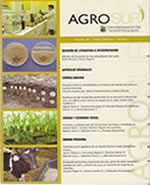Growth-promoting implants in cattle. Effects and its role in a scenario of greater demand and environmental concern
Main Article Content
Abstract
It has been predicted that for the next decades the demand for beef will increase because of the growth of the world population, especially those coming from grass-fed systems. This product, in addition to helping to mitigate climate change, produces food of high biological value in a sustainable way. In this context, the incorporation of technologies that increase the efficiency of agricultural systems is of vital importance. Thus, the concept of sustainable intensification has acquired great relevance. The anabolic growth promoting implants (IAPC) are a widely known technology that can help the beef producer increasing profitability and mitigate environmental impact. Therefore, it is essential to know the effect that its implementation has on production parameters (average daily gain, dry matter intake, and feed conversion), carcass and beef quality (hot carcass weight, loin eye area, dressing, tenderness, backfat, marbling, and general acceptability), and economic (return over investment). With this information, the producer can take better decisions based on his target market. The response to the use of IAPC is variable, which is mainly due to factors such as breed, production system and/or the potency of the implant, that is, its hormonal combination and concentration. The strategic use of IAPC together with beef aging has emerged as options to reduce its possible negative effect on marbling and tenderness, respectively. The IAPCs are a tool to optimize livestock systems and increase the profitability of the beef producer. However, there are few studies on its use in grassland-based livestock systems as well as on its impact on sustainability and mitigation of climate change.

